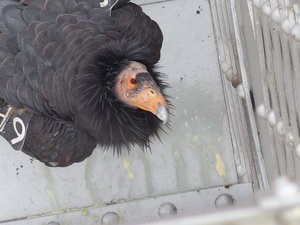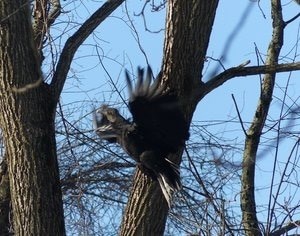Thermal of Conservation
Posted on in On the Mountain by Zoey Greenberg, Education Inter

When I tell people what I like to study, most smile and nod or change the subject. Others don’t beat around the bush and grimace with an “Eww, why?” The simple fact is that many people do not view vultures as glamorous subject matter. However, to me and many folks here at Hawk Mountain, they possess a plethora of attributes worth respecting.
My intrigue with these birds began three years ago when I moved from my home in Washington State to Pennsylvania. I come from a coastal community in which the common ‘big bird’ to point out in the sky is the Bald Eagle, feasting on salmon runs and other fish in Puget Sound. When I arrived here, I was charmed to see that a new silhouette graced the sky in similar abundance – a large raptor that rocked back and forth as if indecisive about which way to fly. At the time, I could relate.
I quickly cultivated a sense of joy in the turkey vulture’s passing shadow, and before long they became a nostalgic symbol of my time on the East coast. I was given an opportunity to expand on my appreciation for vultures as an educator at Shaver’s Creek Environmental Center, in central PA. In this role I often faced an audience partial to raptors with a cuter disposition, such as the owls, hawks, eagles, falcons, osprey…well essentially, everyone else. I took this disparity to heart, considering that the center housed two vultures; a turkey vulture who had been hit by a car and could no longer fly, as well as a black vulture who had recovered from lead poisoning but was still injured from a vehicle collision. I opted to try training the unreleasable vultures for use in educational programs during my time at Shaver’s Creek, in large part because my interactions with the public made it clear that they were unappreciated at best and villainized at worst.

There is, however, one species of vulture in the United States that has achieved genuine fame. Of our three vultures, the California condor lives the most treacherous existence; after a brush with extinction in the 1980’s, a vigorous reintroduction program has kept the miraculous bird in the Southwestern skies. I spent three months researching this bird’s story, and it became clear to me that the condor’s rarity was a catalyst in sparking its public approval. I couldn’t help but be reminded of Rosalie Edge and her wise statement that “the time to save a species is while it’s still common,” and after learning how expensive and heartbreaking the condors’ story has been, I am convinced that it is in everyone’s best interest to avoid a similar situation with our turkey vultures and black vultures.
As a spastically nomadic twenty-four-year-old, I am often asked “what do you want to do?” a question that I follow with a sigh. The truth is, I have flirted with many career paths, and those which have impassioned me most also present a seemingly lifelong battle. Conservation science and education, my most consistent choice, is a field filled with optimism and pessimism in varied amounts. I have seen biologists deliver programs with an emphasis on the sheer beauty of a species, and then end with a long list of threats that may snuff them out entirely. There is nothing easy about that. I have seen conservationists elbow deep in advocacy and education, striving to keep a species from toppling off the edge of existence. There is nothing easy about that.
These reflections have led me to seek out organizations that approach conservation with an interdisciplinary approach, working at an issue from multiple angles, and maintaining an attitude of innovation that targets a problem from the ground up. Hawk Mountain Sanctuary is such a place.

I am here because the Sanctuary has opened its arms to vultures and made their acknowledgment a priority within local, national, and global communities. The Sanctuary reminds young professionals to listen to Rosalie Edge's words of caution, and I believe she would be very proud of Hawk Mountain’s work with common and ecologically significant vultures. I am writing curriculum about black vultures for our education department, with the hope of making vulture studies a convenient and desirable addition to classroom agendas in surrounding schools. Through this work I am becoming more inclined to see the glass half full, and have realized that conservation does not have to be defined by immediate success. Each project is colored with hardship, and in the end, that strife adds to our collective tool box as a conservation community. Even if we don’t save a species now, we can contribute some relief and security to some species.
I am ready to do my part, and one day perhaps my rocky flight will level out to a persistent soar as I join the thermal of conservation that is traveling upward, exactly as it should.
* Zoey's recently developed black vulture curricula with another on the broad-winged hawk was created with support from the Pennsylvania Wild Resources Conservation Program and other donors.